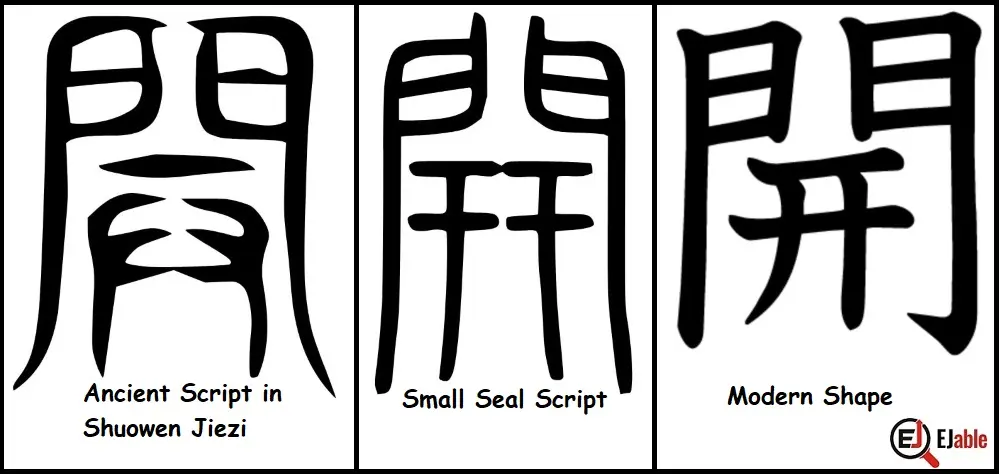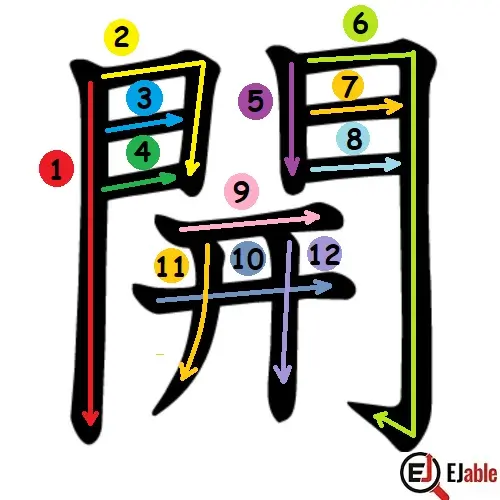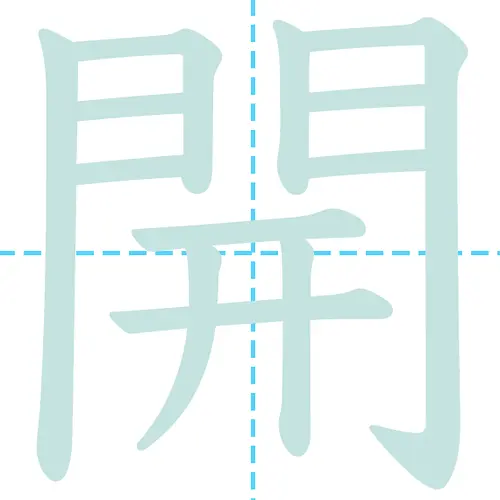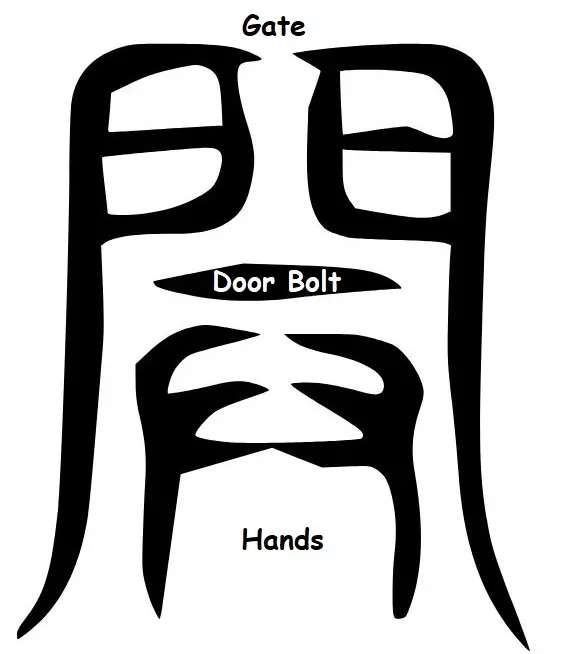Kanji for “Open” and “To Open”: 開 (a-keru / hira-ku)

The Japanese kanji for “Open” is 開.
The kun’yomi (Japanese reading) pronunciation of the Kanji 開 is “hira” (ひら), as in words “hira-keru” (ひら-ける) and “hira-ku” (ひら-く) or “a-keru” (あ-ける), and the on’yomi (Chinese reading) pronunciation of 開 is “kai” (カイ).
The Kanji 開 is widely used in Japanese names and is a part of 833 names. However, in names, it is pronounced as “haru” (はる), “ka” (か), or “hiraki” (ひらき).
The Kanji 開 is constructed with 12 strokes. It is part of the JLPT N4 syllabus (please check the list of JLPT N4 Kanji). In Japanese schools, this Kanji is taught in grade 3.
Origin of the Shape 開
If we see the ancient shape of the Kanji 開 in the Shuowen Jiezi dictionary, it depicts two hands under a door bolt inside a gate, suggesting the action of opening the gate as follows:
Please read the article about the Kanji meaning “gate” to be able to relate 開 with “gate opening” or “open gate.”
Let’s see the evolution of the shape of the Kanji 開 from ancient times to the current:

The above image shows the historical shapes of 開 in the Shuowen Jiezi dictionary, small seal script, and how we write it in the present.
Please note that in the modern shape of the Kanji 開, the shape inside the Kanji of “Gate”. consists of a horizontal top line, which is the bolt of the door, and below that is the 廾 radical, known as either two hands radical or “twenty” radical.
Mnemonic: How to Remember the Kanji Meaning “Open” (開)
It is quite easy to relate the shape 開 to “opening a gate“, and therefore its meaning as “open” with the above-mentioned logic and remembering its ancient shape. However, this Kanji is straightforward to remember if we use the following illustration of a gate or door as a mnemonic:

Let’s have a look at another mnemonic as follows:

Stroke Order for the Kanji 開
The following illustrations show the order of the 12 strokes to write the Kanji 開:


Other Meanings of the Kanji 開
Beyond its primary meaning of opening, 開 carries several additional meanings:
- Begin or Start: 開 can indicate the beginning of an event, period, or activity as if opening a new chapter or phase.
- Open Up or Expand: It can also signify the act of expanding or opening up space, opportunities, or possibilities, broadening the scope of something.
- Hold an Event: 開 is used in contexts related to holding or conducting events, meetings, or ceremonies, as in 開催 (かいさい / kaisai), meaning “to hold (an event).”
- Develop or Cultivate: In some contexts, 開 can refer to the development or cultivation of land, resources, or skills, metaphorically opening up their potential.
開 Kanji in Compounded Words
The kanji for “open” 開 forms part of many compound words. There are 241 Japanese words that begin with the Kanji 開, and it appears in 526 words.
Examples of Kanji 開 in Compounded Kanji Characters
- 開始 (かいし / kaishi): Start or beginning; to begin or commence something.
- 開放 (かいほう / kaihō): Open or release; making something accessible or free to the public.
- 開発 (かいはつ / kaihatsu): Development; the process of developing or opening up new areas or technologies.
- 開門 (かいもん / kaimon): Opening a gate; literally opening the doors or gates, such as of a park or facility.
- 開店 (かいてん / kaiten): Store opening; the start of business hours for a shop or store.
- 開催 (かいさい / kaisai): Holding an event; to hold or conduct an event or exhibition.
- 開業 (かいぎょう / kaigyō): Opening a business; starting up a new business or practice.
- 開通 (かいつう / kai tsū): Opening for traffic; making a road or line available for use.
- 開放的 (かいほうてき / kaihōteki): Open-minded; being receptive to new ideas or opinions.
- 開眼 (かいがん / kaigan): Eye-opening; a term often used in a religious or spiritual context for enlightenment.
- 開設 (かいせつ / kaisetsu): Establishing; setting up or establishing a facility, service, or system.
- 開拓 (かいたく / kaitaku): Cultivation; developing unused land for productive use.
- 開心 (かいしん / kaishin): Open-hearted; feeling happy or joyous, literally having an “open heart.”
- 開会 (かいかい / kaikai): Opening a meeting; the commencement of a meeting or assembly.
- 開講 (かいこう / kaikō): Course offering; the beginning of a lecture or course.
- 開錠 (かいじょう / kaijō): Unlocking; the act of opening a lock.
- 開票 (かいひょう / kaihyō): Vote counting; the process of opening ballot boxes and counting the votes.
- 開示 (かいじ / kaiji): Disclosure; making information or data openly available.
- 開墾 (かいこん / kaikon): Reclamation; clearing and cultivating land for farming or construction.
- 開戦 (かいせん / kaisen): Outbreak of war; the commencement of hostilities or conflict.
The above examples of compound words show the diverse applications of 開 in Japanese, representing concepts related to the initiation, opening, and beginning across various contexts.
Note: Check other Kanji characters on the page “How to Remember Kanji“. You may also like to read about common Kanji radicals.

A long-term ex-pat in Japan, Himanshu comes with an IT background in SAP consulting, IT Business Development, and then running the country operations of an IT consulting multinational. Himanshu is the co-founder and Managing Director of ReachExt K.K. and EJable.com. He is also an Advisory Board Member of a Silicon Valley AI/IoT startup.

